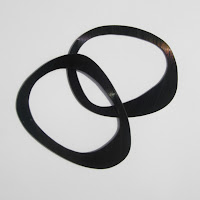And when most people were Christmas shopping or drinking egg nog round the fire what had I braved the cold for? Seizure, that's what. An installation within a 1960s block of derelict flats by recent Turner-prize nominee Roger Hiorns, Seizure is a fairytale flat built of blue crystals.

Crystallised copper sulphate to be exact. When I finally located 159 Harper Road, off New Kent Road, it wasn't quite the magical grotto I'd envisaged (too brightly lit in places) but spectacular nevertheless. Not least because it's a blue jewel in the middle of a grim and grey old council estate. Even better, you could touch all the glittering crystals which makes a change from most gallery exhibitions. I was in there on my own at one point and it is really eerie, almost like being underwater.

Hiorns changes familiar objects by introducing chemical materials to add an element of chance. With Seizure, 95,000 litres of copper sulphate solution were boiled to 100 degrees and pumped into the bed-sit (which had been made watertight) and left for three weeks to cool down. Once the flat was drained, the crystals began to form on the walls and ceiling. Cool, eh?

The Birmingham born artist was the favourite to win the Turner prize because of the inventiveness of this particular work (the prize is judged on work exhibited by the nominated artists in the past twelve months). Alas he lost out to Richard Wright's gold leaf embossed design currently on show at the Turner Prize exhibition at Tate Britain.
I visited the exhibition before seeing Seizure and I was really impressed with the concepts behind Hiorns' work. As he often experiments he doesn't know what the end results will look like because the materials are unpredictable (he's used fire and detergent foam in previous works).
One untitled work on show at Tate Britain is a heap of grey and black dust which turned out to be an atomised passenger jet engine. Eventually everything turns to dust. Another was a latticed steel frame holding soap-size bars of blackish yellow powder blocks. These turned out to be made of "brain matter". Whose brain (human, pig, gerbil?) I'm not sure but the work isn't displayed in a "look at what I'm made of" type of way (like Marc Quinn's Self made out of blood for instance) but is far more thoughtful and subtle. I like the way he integrates things which were living or are living with man-made structures to form art.
Tate Britain has put up notice boards (great idea) at the exit of the Turner Prize where people have written hundreds of comments. While many of them praise the prize winner Richard Wright (whose work is beautiful and made even more so by its ephemeral nature - everything he paints is destroyed as he believes art is for the present not the future), an equal number were in favour in Hiorns. As one commentator said "Long live brain matter!".
Seizure and the Turner Prize at Tate Britain both run until 3rd January.
Happy Christmas everyone!

















































